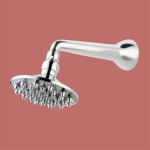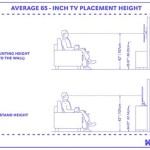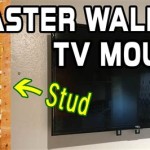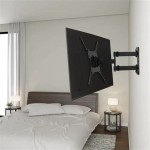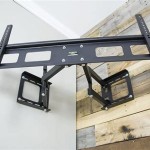How High on the Wall Should a TV Be Mounted?
Determining the ideal height for mounting a television on a wall is a crucial aspect of home theater design and overall viewing comfort. Mounting a TV too high or too low can lead to neck strain, eye fatigue, and a less immersive viewing experience. Several factors influence the optimal mounting height, including the size of the TV, the distance between the viewer and the screen, the typical viewing position, and the desired aesthetic.
The goal is to position the TV screen so that the viewer's eyes are level with or slightly below the center of the screen when in a seated position. This minimizes neck strain and promotes a more comfortable and natural viewing experience. Achieving this requires careful consideration of various parameters and a thoughtful approach to the installation process.
One common mistake is mounting a TV too high, often mimicking the placement seen in public spaces like sports bars or waiting rooms. While this might be suitable for environments where viewers are often standing, it is generally not ideal for residential settings where viewers are primarily seated. Mounting the TV at eye level, or slightly below, is almost always the preferred option for home viewing.
Accurately determining the correct placement is not an exact science, but rather a combination of guidelines and personal preference. Taking the time to investigate and plan before drilling any holes in the wall will significantly improve the viewing experience and prevent the need for costly adjustments later on.
Key Considerations for Determining TV Mounting Height
Several key factors should be taken into account when determining the optimal height for mounting a television. These factors interact with each other, and a holistic approach is necessary to find the placement that best suits individual needs and preferences. Ignoring any of these factors can lead to a less than ideal viewing experience.
1. TV Screen Size and Viewing Distance
The size of the television screen is a primary determinant of the ideal viewing height. Larger screens typically require a slightly higher mounting position to ensure the entire screen is comfortably visible from a seated position. The reasoning is straightforward: larger screens occupy a greater vertical space, and thus the optimal viewing angle changes.
Viewing distance, the distance between the viewer's eyes and the television screen, also plays a significant role. As viewing distance increases, the mounting height can generally be raised slightly without causing discomfort. Conversely, when viewers are seated closer to the screen, a lower mounting height is often preferable. There's a direct relationship between distance, screen size, and the angle of view required for comfortable immersion.
A common guideline is to aim for a viewing angle where the top of the screen is no higher than 15 degrees above eye level and the bottom of the screen is no lower than 15 degrees below eye level. This range ensures comfortable viewing without excessive head or neck movement. To achieve this, one can use online viewing distance calculators which take into account screen size and preferred viewing distance to suggest a recommended mounting height.
For instance, a 65-inch TV viewed from 10 feet away might be mounted with the center of the screen roughly 40-45 inches from the floor. Conversely, a 55-inch TV viewed from 8 feet away might be mounted slightly lower, with the center of the screen around 35-40 inches from the floor. Precise measurements will depend on the viewer's seated eye height.
2. Seating Arrangement and Viewing Position
The height and style of the seating arrangement significantly impact the optimal TV mounting height. Low-slung couches and chairs will require a lower mounting position compared to higher seating options, such as bar stools or reclining chairs. The goal is to ensure that the viewer's eyes are aligned with the center of the screen, or slightly below, regardless of the seating height.
Furthermore, the typical viewing position should be considered. Do viewers primarily sit upright, recline, or lie down while watching television? A reclining position might necessitate a slightly higher mounting height to compensate for the reclined posture. Similarly, if viewers frequently lie down, a significantly higher mounting position may be required to avoid neck strain.
To accurately determine the optimal mounting height, it is beneficial to measure the eye height of viewers while they are seated in their typical viewing position. This measurement can then be used to calculate the ideal center screen height. For example, if the average eye height of seated viewers is 42 inches, the center of the TV screen should ideally be positioned around this height.
Consider the primary viewing location. If the TV is in a bedroom and intended for viewing while lying in bed, the calculation changes entirely. In this scenario, the TV will almost certainly need to be mounted higher than the standard seated eye-level to provide a comfortable viewing angle.
3. Aesthetic Considerations and Room Layout
Beyond purely ergonomic considerations, aesthetic factors also play a role in determining the optimal TV mounting height. The overall design of the room, the placement of furniture, and the presence of architectural features can all influence the perceived aesthetic of the TV placement.
For example, mounting the TV above a fireplace is a common design choice, but it often results in a mounting height that is significantly higher than ideal. In such cases, careful consideration should be given to the potential trade-offs between aesthetics and viewing comfort. Alternative solutions, such as lowering the fireplace mantle or using a tilting TV mount, may help mitigate the issues associated with high TV placement.
The presence of windows or other light sources should also be considered. Mounting the TV in a location where it is directly exposed to sunlight can cause glare and reduce image quality. Adjusting the mounting height or using window coverings can help minimize these issues. Room lighting and viewing angles should be carefully considered to mitigate glare and reflection problems. This sometimes mandates a change in mounting height to best optimize the viewing experience.
Furthermore, the overall balance of the room should be taken into account. A TV that is mounted too high or too low can disrupt the visual harmony of the space. Striving for a balanced and aesthetically pleasing arrangement will enhance the overall viewing experience and contribute to a more comfortable and inviting living environment.
Finally, cable management is a practical consideration. Ensuring that cables are neatly concealed and organized will improve the overall appearance of the installation. Choosing a mounting location that allows for easy access to power outlets and cable connections will simplify the installation process and facilitate future maintenance.
In conclusion, while technical considerations like eye level and viewing distance dictate the primary placement of the TV, the final decision almost always involves a degree of compromise and negotiation with the aesthetic goals of the space.

How High Should A Tv Be Mounted The Plug Hellotech

At What Height Should Your Flat Screen Be Mounted Nextdaytechs On Site Technical Servicesnextdaytechs Services

How High Should Your Tv Be Mounted Reviews By Wirecutter

How High To Mount A Tv In The Home Cepro

Tv Mounting Height Calculator

How High Should You Mount A Tv On The Wall House Of Hipsters

Heightfinder Sanus

How High Should You Mount A Tv On The Wall House Of Hipsters

News Tv Wall Mount Installation Tips For The Experts Mhtg

Ideal Tv Wall Mount Height A Comprehensive Guide


